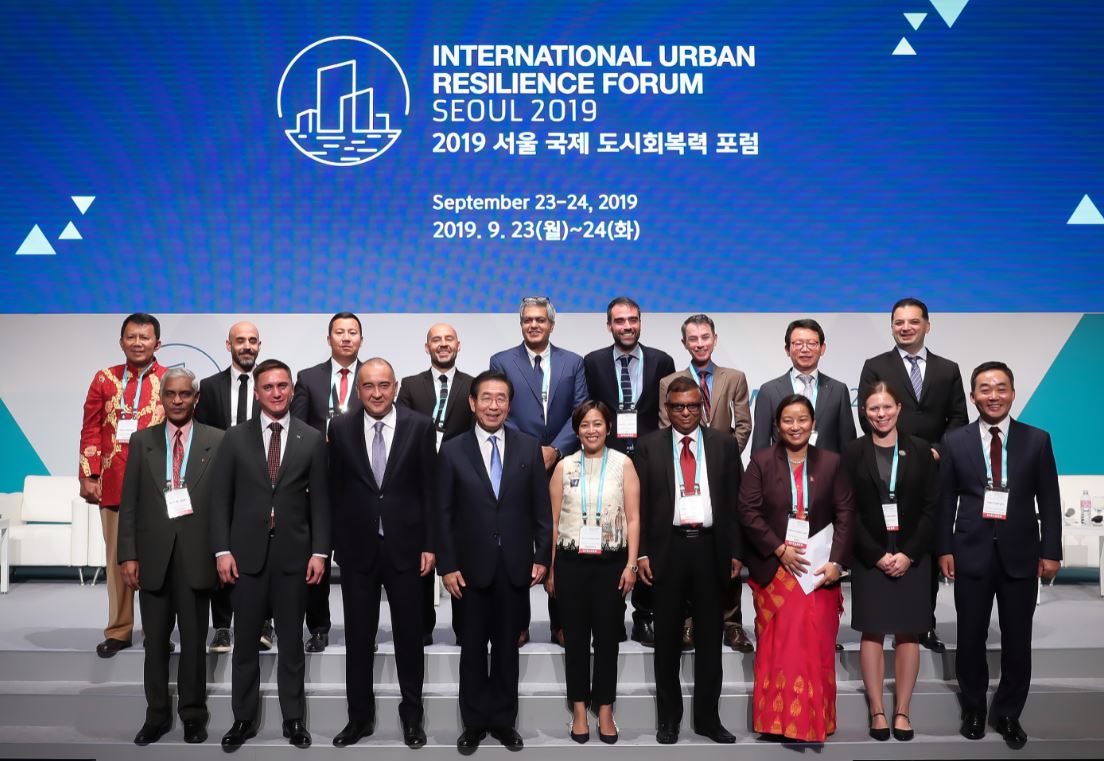It wasn’t long ago, really, when kayaking to class was seriously considered by students. With enough rainfall, and with Hoboken’s aging sewer system, residents of the Mile Square City sometimes had to trudge through several inches of flooding when walking out their front doors.
But that was over a decade ago. Now, after years of sewer upgrades, two wet weather pumping stations, two resiliency parks, and an increased focus on green infrastructure, the severity and frequency of flooding have dropped dramatically. That Hoboken’s sewers can handle the waste of residents on a daily basis — plus the occasional downpour or major storm — is a testament to its resilience. And it hasn’t gone unnoticed.
Earlier this month, Hoboken was invited by the United Nations Office for Disaster Risk Reduction and the Seoul Metropolitan Government to attend the “International Urban Resilience Forum.” Hoboken was joined by other top cities around the world to discuss and share best practices in urban resilience.
Urban resilience, a term popularized in the recent decade, refers to a local government’s ability to plan and respond to natural hazards. “A good recovery is that it can prevent or minimize damage due to its high resistance,” the United Nations described on the forum’s website. “It also means that the lives of the city’s inner circle can continue even if the damage occurs, and that it can quickly return to its original state or beyond.”
Representatives from San Francisco, Tel-Aviv, Seoul, others — and, of course, Hoboken — spoke about their cities’ best practices in urban resilience. These practices include replacing non-porous surfaces with green space whenever possible, mitigating flood risk with upgraded sewer infrastructure, and updating emergency preparedness in cases of extreme natural disaster.
These conversations on urban resilience aren’t new for Hoboken. The city has been committed to urban resilience for a while now. Four years ago, the United Nations named Hoboken a role model city in its “Making Cities Resilient” campaign. This campaign, which Hoboken joined six years ago, launched in May 2010 in response to the intensifying worldwide climate crisis. The United Nations posits that real risks exist, and will worsen, if local governments don’t make immediate, environmentally-focused infrastructure changes to their cities.
Ahead of other major cities across the United States, Hoboken proposed and enacted its Green Infrastructure Strategic Plan in October 2013. Back in 2013, the increasing severity of flooding had created significant challenges for Hoboken’s stormwater management system. Between 2002 and 2012, for example, “the City recorded 26 dates with greater than 2 inches of precipitation and tides of 4 feet or higher,” Hoboken said in their strategic plan.
But it wasn’t just flooding that prompted Hoboken to pursue an ambitious green infrastructure plan. “It was also water quality and public health benefits,” said Jennifer Gonzalez, Director of Environmental Services, in a phone interview. “Green infrastructure can filter pollutants to improve water quality.”
Green infrastructure approaches water management more effectively than traditional “gray infrastructure” methods of treating rainwater. While traditional stormwater infrastructure — say, piped drainage and water treatment systems — is designed to simply move urban stormwater away from the city, green infrastructure reduces and treats stormwater at its source while delivering environmental, social, and economic benefits.
In Hoboken, for example, green infrastructure means redesigning Washington Street with rain gardens — sloped, linear areas designed to concentrate and collect stormwater while also filtering out dirt and debris. “Our goal is to keep excessive amounts of rainwater from entering the sewer system during the rainstorm,” said Gonzalez. By installing green infrastructure, less rainwater enters the sewer system during a storm and flooding is less likely.
Hoboken also has been, it seems, adding parks everywhere. Not only do these parks add open space in a dense city, but they also double as green infrastructure. Taking up a total of five acres of former industrial land surrounded by Madison Street, Adams Street, 12th Street, and 13th Street, the Northwest Resiliency Park will become Hoboken’s largest park and “will include above ground green infrastructure and a flood detention system underground,” according to a release from the city. It will have the capacity to hold two million gallons of rainfall and include a skating rink, athletic fields, and more.
Significant progress has been made, and more projects are underway, to include green infrastructure in Hoboken. “We’ve accomplished a lot,” Gonzalez said, “but there’s certainly more we can do.” This means more park space that also reduces flood risk and new rain gardens to ease pressure on the sewer system — and advancing conversations at an international level, like the one in Seoul, to encourage other cities to take on urban resiliency initiatives.
At the end of the International Urban Resilience Forum, Hoboken and 15 other cities signed the “Seoul Declaration to Strengthen Urban Resilience.” The declaration encourages cities to partner together to build cities that are resilient to present and future natural disasters.
“Investing in disaster risk reduction and resilient infrastructure helps to minimize future losses,” the declaration says, “and also ensures that disruption in people’s lives are kept to a minimum. As the world becomes increasingly urban and climate change brings greater uncertainty, city and local governments will play a leading role in addressing existing and new shocks and stresses.”

Be First to Comment